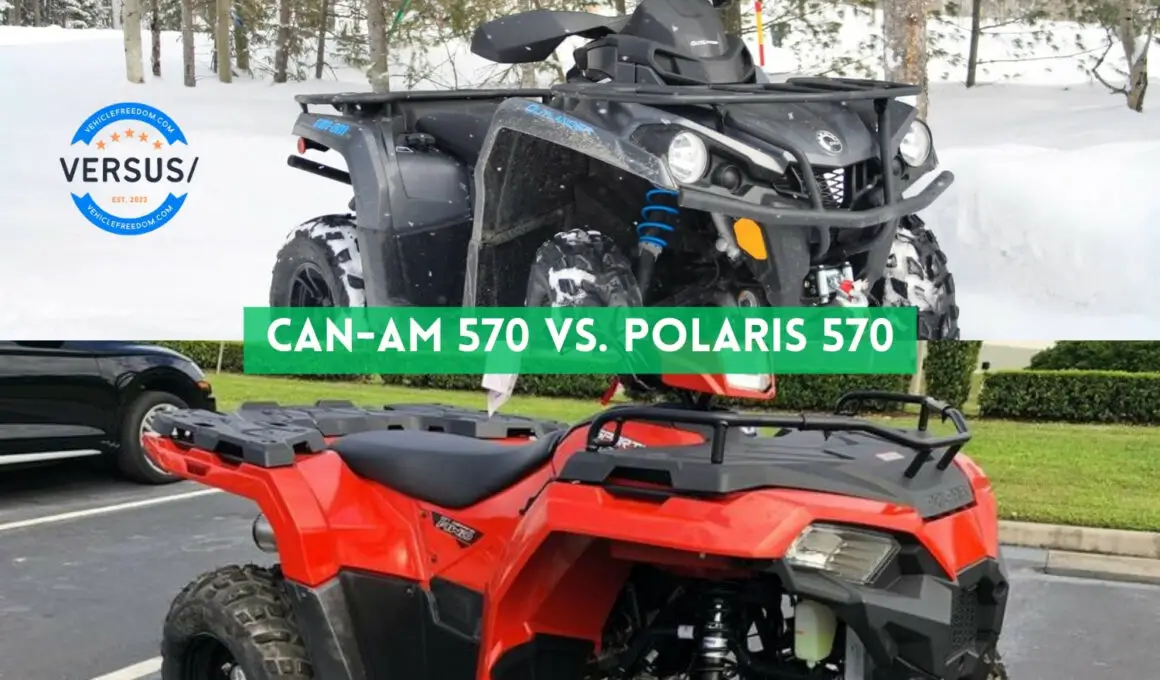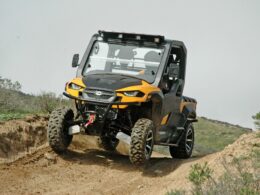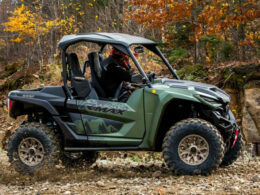In This Article Show
Navigating the rugged terrains and open trails is an experience, and I’ve been fortunate enough to dive deep into this world for years. From the adrenaline-pumping action of dirt bikes to the utility and thrill of ATVs and UTVs, my passion has led me to experience, test, and understand the equipment that makes these adventures possible.
Today, we’re going to embark on an exciting journey of discovery. The debate is as old as the trails: Can-Am 570 or Polaris 570? Which of these esteemed ATVs takes the lead? I’ve been hands-on with both and am eager to share my insights with you.
Just like we’ve kept it simple in our wildly popular Polaris 450 vs. Polaris 570, this one will remove the unneeded info and keep the comparison as simple as possible, highlighting the differences, similarities, and what sets these two ATVs apart, let’s begin.
Brand Overview
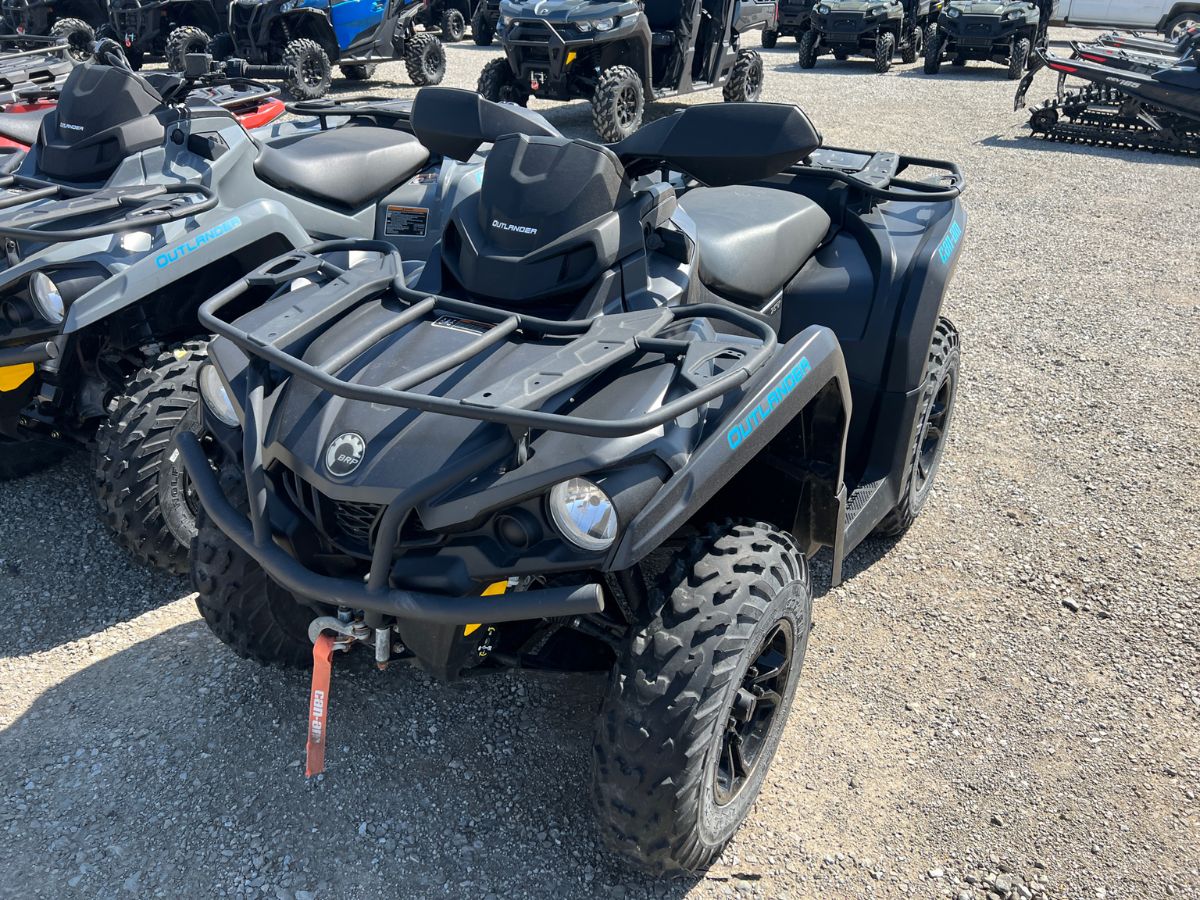
Can-Am
When we talk about Can-Am, we’re diving into the rich history of a brand that’s become synonymous with off-roading excellence. Born from the umbrella of Bombardier Recreational Products, Can-Am has its roots firmly planted in the motorsports arena.
Since their debut in the 1970s, initially with motorbikes, they’ve shifted their focus to off-road vehicles, making an indelible mark on the industry.
One of the reasons off-road enthusiasts, like myself, have gravitated towards Can-Am is their unwavering commitment to innovation. Whether it’s their proprietary Rotax engines, which offer a beautiful blend of power and efficiency, or their advanced chassis designs, this brand is always a step ahead.
Polaris
Polaris – a name that’s echoed in the trails, dunes, and everywhere in between. Originating in the snowy landscapes of Minnesota in the 1950s, Polaris began its journey with snowmobiles. But as seasons changed, so did their offerings. The introduction of their ATVs in the 1980s was a game-changer, and they’ve been a dominant force in the off-road community ever since.
Polaris stands out for its sheer versatility. Over the years, they’ve produced top-notch ATVs and ventured into various terrains with their RZRs, Rangers, and more. Their dedication to rider experience is evident.
Ask any Polaris owner, and they’ll tell you about the smooth rides, the intuitive controls, and the robust build that comes as a standard.
While having distinct histories and paths, both brands converge in their passion for off-roading. Having personally ridden models from both makers, I can testify that choosing between them isn’t a mere matter of specs – it’s about individual preferences, brand loyalty, and the kind of experience you’re seeking on the trails.

Performance & Power
1. Engine Specs
Diving straight into the heart of any ATV, we must discuss the engines. The machinery that drives our experiences, that feeling of exhilaration, boils down to what’s under the hood.
Can-Am 570
Powered by the signature Rotax engine, the Can-Am 570 boasts a V-twin setup that’s built for power and reliability. With a displacement of 570cc, this engine is not just about raw strength; it’s designed for optimal airflow, efficient cooling, and a balanced power delivery. It’s no wonder the throttle response feels so immediate and gratifying.
Polaris 570
The ProStar 570 engine drives the Polaris. It’s a single-cylinder, 4-stroke DOHC powerhouse. Though a different configuration from the Can-Am, it doesn’t hold back. Delivering a solid torque curve and a smooth power output, it’s built to perform.
The fuel injection ensures it fires up quickly, even in colder conditions, and maintains consistent performance across terrains.
2. Handling & Suspension
There’s more to an ATV than just raw power. It’s about how it responds to your commands, especially when navigating tricky terrains.
Can-Am 570
With its Double A-arm front suspension and Torsional Trailing arm independent rear suspension, Can-Am guarantees a smooth ride. The generous ground clearance allows riders to glide over obstacles relatively easily. The power steering is responsive, ensuring that handling remains a breeze even on tougher trails.
Polaris 570
Polaris opts for MacPherson struts at the front and an Independent Rear Suspension at the back. The result? Stability, even at higher speeds and on uneven terrains.
In some models, the Electronic Power Steering (EPS) feature ensures reduced fatigue, particularly during longer rides, making sharp turns and complex maneuvers feel effortlessly controlled.
3. Speed & Acceleration
For those who crave the thrill of speed, these ATVs don’t disappoint.
Can-Am 570
It’s not just about reaching top speeds, but how quickly you get there. The Can-Am 570’s acceleration is zippy and linear, ensuring that you’re not left waiting when you punch that throttle. As for top speed, you’re looking at numbers north of 50 mph, depending on conditions and rider weight.
Polaris 570
With its well-tuned transmission, the Polaris offers rapid acceleration, exhilarating zero-to-top-speed dashes. It competes neck-and-neck with the Can-Am in terms of top speed, again easily surpassing the 50 mph mark under optimal conditions.
Bottom line 👍
Both machines are finely tuned beasts in the realm of performance and power. They are optimized for different experiences.
While the Can-Am might appeal to those with a penchant for responsive and immediate power, the Polaris leans towards those valuing stability and consistent, smooth performance. But, let’s not forget: with either choice, the trails await with promise and excitement.
Design & Build Quality
1. Aesthetics & Styling
The aesthetics of an ATV can be subjective, but some objective elements set each brand apart, transforming these vehicles from mere machines to pieces of art.
Can-Am 570
Sleek yet aggressive, the Can-Am sports an unmistakably futuristic design. The sharp angles and dynamic lines give it an aerodynamic appearance, even when stationary. Accentuated by LED lights and a distinctive grille, it stands out on any trail. Plus, with various color options and customizable graphics, you can truly make it your own.
Polaris 570
Classic with a touch of modernity. The Polaris has a more rounded and traditional ATV shape but isn’t shy to integrate modern design cues. The headlights, the protective fenders, and the ergonomic seating all combine to create an ATV that’s pleasing to the eyes yet functional. The color palettes and finishes are both robust and elegant, catering to a broad range of tastes.
2. Durability & Materials
ATVs are built for rugged terrains, and their build quality reflects their purpose.
Can-Am 570
Can-Am uses a robust steel frame construction, ensuring a sturdy foundation. The materials, from the protective skid plates to the reinforced body panels, are selected to withstand the regular bumps and grinds of off-roading and the unpredictable challenges that adventurous trails might throw.
Polaris 570
Durability is a cornerstone of the Polaris brand. With its high-strength steel chassis and advanced protective coatings, it’s built to last. The weight distribution and design are such that it minimizes strain on key components, thereby extending the ATV’s lifespan. The protective elements, from the fenders to the underbody shields, demonstrate meticulous attention to detail.
3. Rider Comfort
An ATV’s true test is how it treats its rider, especially during longer rides.
Can-Am 570
Can-Am’s emphasis on ergonomics is evident. The seat is cushioned and contoured, accommodating various body types comfortably. The handlebars are positioned for optimal reach, reducing rider fatigue. Plus, with spacious footwells and intuitive control placements, the riding experience feels both relaxed and in control.
Polaris 570
Polaris doesn’t skimp on comfort either. The seating is plush, with adequate support for both the rider and a potential passenger. The legroom is generous, ensuring even taller riders won’t feel cramped. Control levers and switches fall easily to hand, and the layout is designed keeping both novice and seasoned riders in mind.
Key takeaway 📝
Both ATVs make a compelling case when evaluating the design and build quality. Can-Am leans more towards the avant-garde, while Polaris remains rooted in a blend of tradition and innovation. Regardless of the choice, riders can rest assured that they are investing in eye-catching machines built to stand the test of time and terrain.
Features & Technology
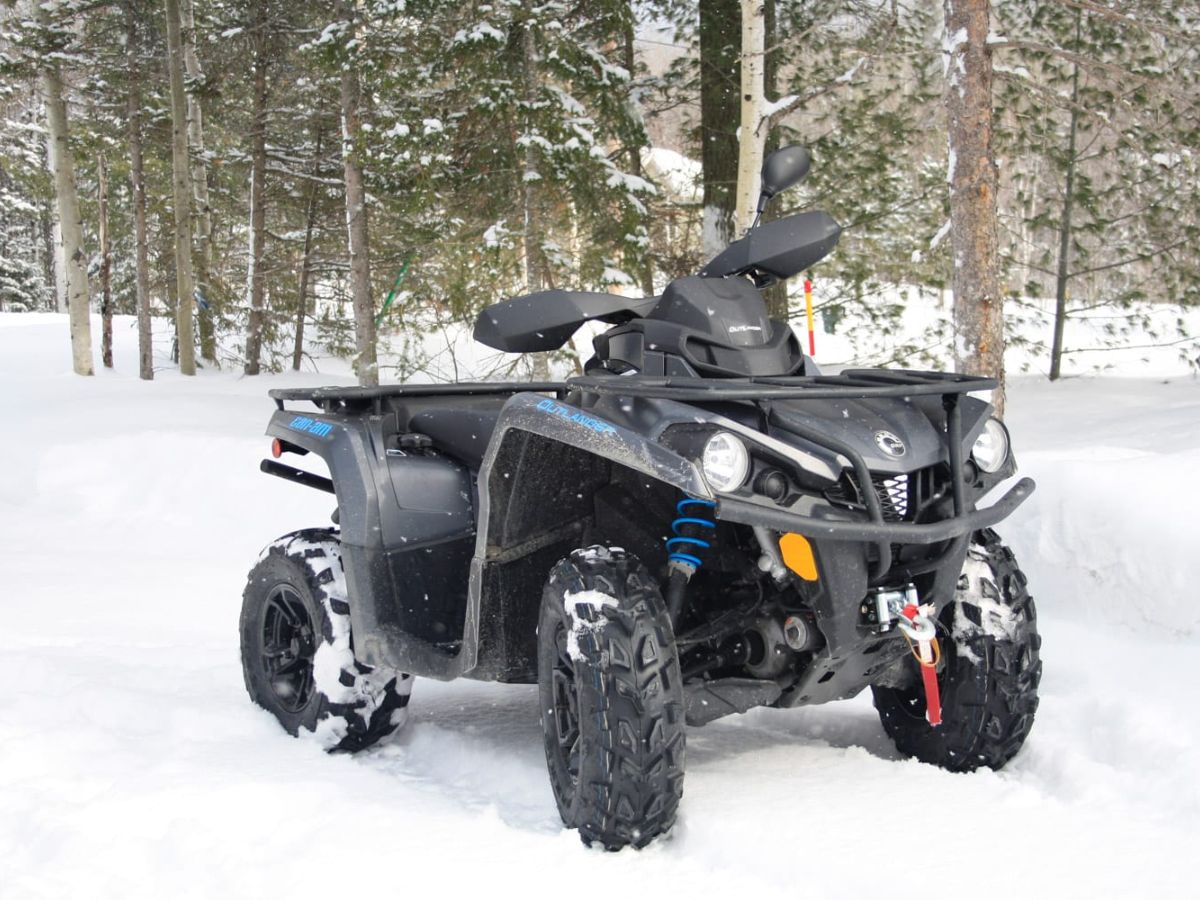
1. Onboard Technology
Today’s ATVs are more than rugged machines – they’re equipped with technology that enhances the ride experience, offering both functionality and convenience.
Can-Am 570
- Digital Display: A multi-function digital dashboard provides all the vital information at a glance – from speed and fuel levels to diagnostics and maintenance alerts.
- Eco Mode: For the environmentally conscious rider, the Eco mode optimizes fuel consumption without compromising on performance.
- Intelligent Throttle Control (iTC): This offers a more responsive and smoother throttle delivery, ensuring riders can maintain better control in varying terrains.
Polaris 570
- RideCommand: Available in some models, this interactive touchscreen system offers GPS navigation, Bluetooth connectivity, and other vital stats – turning your ATV into a smart ride.
- Electronic Fuel Injection (EFI): Ensures the engine always gets the right amount of fuel, enhancing efficiency and performance, especially during cold starts or high-altitude rides.
- Engine Braking System (EBS): This adds an extra layer of control, especially when descending, by using the engine to assist in slowing the ATV.
2. Safety Features
Safety is paramount, and both brands have incorporated features to ensure rider well-being.
Can-Am 570
- Visco-Lok QE Auto-locking Front Differential: This ensures optimal power transfer to the wheels, improving stability, especially on slippery terrains.
- Rollover Protection Structure (ROPS): A built-in protective framework minimizes risks during inadvertent rollovers.
- Advanced Traction Control: Keeps the ATV grounded and responsive, even on challenging terrains.
Polaris 570
- Electronic Power Steering (EPS): Helps in reducing rider fatigue by providing assisted steering, especially beneficial during long rides or when navigating through tight trails.
- Active Descent Control (ADC): Makes downhill terrains more manageable by maintaining a consistent speed and preventing free-rolling.
- Puncture-resistant Tires: Designed to withstand tough terrains, these tires reduce the risk of sudden flats.
3. Additional Amenities
It’s the little things that often elevate the riding experience.
Can-Am 570
- Modular Seating: For those who occasionally want company, the seating can be adjusted to accommodate a passenger.
- Integrated Storage: Built-in compartments allow riders to store essentials, making longer trips more convenient safely.
- Winch: An optional, factory-installed winch proves invaluable in sticky situations or when helping out fellow riders.
Polaris 570
- Lock & Ride Storage: This offers the flexibility of adding or removing storage components based on the journey.
- Adjustable Driver Seat: Allows riders of varying heights to find their perfect seating position.
- Towing Capacity: With a sturdy hitch, the Polaris 570 is ready to tow, adding to its utility.
In an era where technology seamlessly blends with utility, both Can-Am and Polaris have upped the ante. While Can-Am offers features that make the ride smoother and more intuitive, Polaris shines with its utility-first approach, ensuring riders have everything they need for any adventure.
Choosing between them is akin to selecting between a high-end sports car and a luxury SUV – both are exceptional, but cater to slightly different desires.
Cost & Value
When considering an ATV, the price tag is undeniably a major factor. But it’s crucial to look beyond just the initial cost and evaluate each vehicle’s overall value in terms of longevity, performance, and potential maintenance.
1. Initial Purchase Price
Both Can-Am and Polaris have a range of models under the 570 banner, each catering to different budgets and feature sets.
Can-Am 570
Can-Am ATVs tend to sit on the higher end of the price spectrum. Their focus on innovation, premium design aesthetics, and brand prestige can come with a slightly heftier tag. However, you’re paying for a combination of top-tier performance and a machine that stands out both in terms of appearance and capabilities.
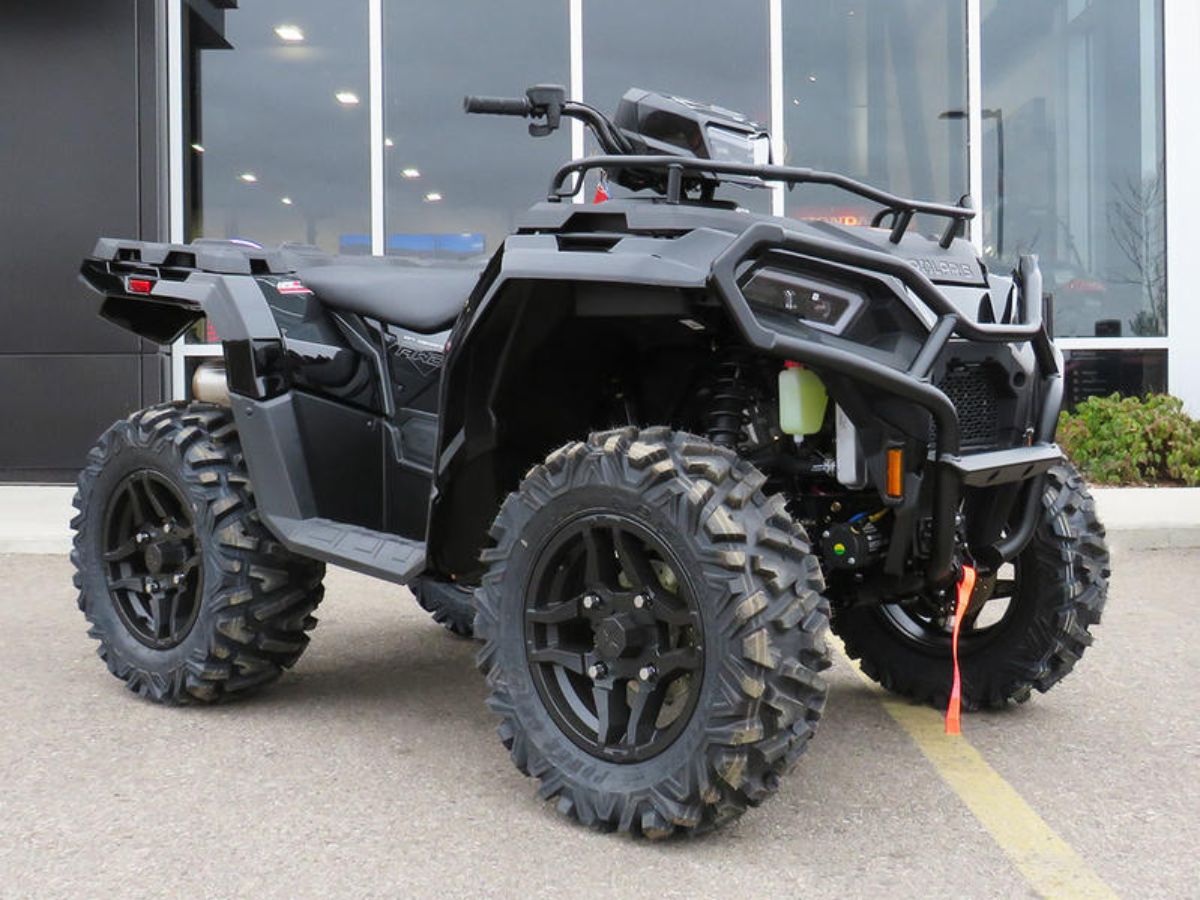
Polaris 570
Polaris offers a competitive price range, often coming in a tad lower than Can-Am for comparable models. Their wide distribution network and economies of scale might be contributing factors.
But make no mistake; a slightly lower price doesn’t mean a compromise on quality or performance. It’s more about Polaris’s approach to offering robust, no-nonsense vehicles that deliver solidly on their promise.
2. Maintenance & Longevity
Owning an ATV is a long-term commitment; understanding the potential maintenance costs can prevent future surprises.
Can-Am 570
With its advanced technology and features, some might worry about higher maintenance costs. While certain parts or proprietary tech might be pricier to replace or service, Can-Am ATVs are designed for durability. Regular care and adhering to service schedules can ensure these machines run smoothly for years.
Polaris 570
Known for their rugged build, Polaris ATVs often boast longer intervals between necessary maintenance. Parts are relatively accessible, and given the brand’s popularity, many mechanics are well-versed in servicing them. This can lead to potentially lower upkeep costs over the long run.
3. Resale Value
A good measure of an ATV’s worth is how it retains value over time.
Can-Am 570
Given its premium positioning in the market, Can-Am generally enjoys a decent resale value. The brand’s reputation for innovation and quality makes used models desirable, especially if they’ve been well-maintained.
Polaris 570
With its widespread recognition and trust within the off-roading community, Polaris also holds its value well. Their vehicles are known for longevity, and potential buyers often feel confident in purchasing a pre-owned model, knowing they’re investing in reliability.
Finally
Deciding between Can-Am and Polaris based on cost and value can be a balancing act.
While Can-Am may appeal to those looking for premium features and distinct aesthetics, Polaris offers robust performance and durability that might come with a friendlier initial price point.
Ultimately, the decision should align with individual preferences, intended use, and budget considerations. Both brands have proven their worth in the off-roading arena, guaranteeing riders will get value, irrespective of their choice.






